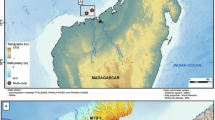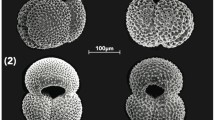Abstract
Size restricted carbon isotopes (δ13C) are used to track changes in the ontogenetic life strategies of two species of extinct planktonic foraminifera and demonstrate that the species Morozovelloides crassatus lost their photosymbiotic association prior to their extinction in the latest middle Eocene. M. crassatus exhibit a strong positive correlation between test size and δ13C between 39.5 Ma and 38.7 Ma and a Δδ13C shift of 1.0‰/100 μm, this is analogous with modern species that possess an association with algal photosymbionts. Turborotalia cerroazulensis is interpreted as an asymbiotic, thermocline dweller and consistently shows no size related δ13C trends and greater δ18O values in comparison to Morozovelloides. We show a long-term (1.5 million year) deterioration of Morozovelloides ecology that culminated in their extinction at 38.021 Ma. The Δδ13C /100 μm in M. crassatus is dramatically reduced from 1.0‰ at 39.53 to only 0.2‰ at 38.026 Ma, 5 kyr before their extinction. The decline in ontogenetic δ13C suggests diminished photosymbiotic activity (bleaching) and disruption of foraminiferal ecology in the interval preceding their extinction. We conclude that the demise of Morozovelloides was directly related to the deterioration of photosymbiotic partnerships with algae.






Similar content being viewed by others
References
Addessi L (2001) Giant clam bleaching in the lagoon of Takaopto Atoll (French Polynesia). Coral Reefs 19:220
Bé AWH (1982) Biology of planktonic foraminifera. In: Broadhead T (ed) Foraminifera: notes for a short course (Stud. Geol., 6). Univ. Knoxville, Tenn., pp 51–92
Bé AWH, Spero HJ, Anderson OR (1982) Effects of symbiont elimination and reinfection on the life processes of the planktonic foraminifer Globigerinoides sacculifer. Marine Biol 70:73–86
Berger WH, Vincent E (1986) Deep-sea carbonates: reading the carbon-isotope signal. Geologishe Rundsch 75:249–269
Berggren WA, Kent DV, Swisher CC III, Aubry M-P. (1995) A revised Cenozoic geochronology and chronostratigraphy. In: Berggren WA, Kent DV, Aubry M-P, Hardenbol J (eds) Geochronology, time scales and global stratigraphic correlation: a unified temporal framework for an historical geology society of economic paleontologists and mineralogists. Special publication 54, pp 129–212
Berggren WA, Pearson PN (2005) A revised tropical to subtropical Paleogene planktonic foraminiferal zonation. J Foraminiferal Res 35:279– 298
Berggren WA, Pearson PN, Huber BT, Wade BS (2006) Chapter 9:taxonomy, biostratigraphy and phylogeny of Eocene Acarinina. In: Pearson PN, Olsson RK, Huber BT, Hemleben C and Berggren WA (eds) Atlas of Eocene planktonic foraminifera. Cushman Foundation Special publication, vol 41, pp 257–326
Bijma J, Erez J, Hemleben C (1990) Lunar and semi-lunar reproductive cycles in some spinose planktonic foraminifers. J Foraminiferal Res 20:117–127
Boersma A, Premoli Silva I, Shackleton NJ (1987) Atlantic Eocene planktonic foraminiferal paleohydrographic indicators and stable isotope paleoceanography. Paleoceanography 2:287–331
Bouvier-Soumagnac Y, Duplessy JC (1985) Carbon and oxygen isotope composition of planktonic foraminifera from laboratory culture, plankton tows and recent sediment: implications for the reconstruction of paleoclimatic conditions and of the global carbon cycle. J Foraminiferal Res 15:302–320
Caron DA, Bé AWH, Anderson OR (1981) Effects of variations in light intensity on life processes of the planktonic foraminifer Globigerinoides sacculifer in laboratory culture. J Marine Biolog Assoc UK 62:435–451
Coccioni R, Monaco P, Monechi S, Nocchi M, Parisi G (1988) Biostratigraphy of the Eocene-Oligocene boundary at Massignano (Ancona, Italy). International Subcommission on the Paleogene, Eocene Oligocene Meeting, Ancona. Special publication 2, pp 59–80
D’Hondt S, Zachos JC, Schultz G (1994) Stable isotopic signals and photosymbiosis in Late Paleocene planktic foraminifera. Paleobiology 20:391–406
Douglas AE (2003) Coral bleaching – how and why? Marine Pollut Bull 46:385–392
Erez J (1978) Vital effect on stable-isotope composition seen in foraminifera and coral skeletons. Nature 273:199–202
Gast RJ, Caron DA (2001) Photosymbiotic associations in planktonic foraminifera and radiolarian. Hydrobiologia 461:1–7
Glynn PW (1996) Coral reef bleaching: facts, hypotheses and implications. Glob Change Biol 2:495–509
Grottoli AG, Rodrigues LJ, Juarez C (2004) Lipids and stable carbon isotopes in two species of Hawaiian corals, Porites compressa and Montipora verrucosa, following a bleaching event. Marine Biology 145:621–631
Hallock P (1981) Algal symbiosis: a mathematical analysis. Marine Biol 62:249–255
Hallock P (2000) Symbiont-bearing foraminifera: harbingers of global change? Micropaleontology 46(suppl no. 1):95–104
Hallock P, Lidz BH, Cockey-Burkhard EM, Donnelly KB (2003) Foraminifera as bioindicators in coral reef assessment and monitoring: the FORAM Index. Environ Monit Assess 81:221–238
Hallock P, Talge HK, Cockney EM, Muller RG (1995) A new disease in a reef- dwelling foraminifera: implications for coastal sedimentation. J Foraminiferal Res 25:280–286
Hemleben C, Spindler M, Anderson OR (1989) Modern planktonic foraminifera. Springer-Verlag, New York
Kelly DC, Arnold AJ, Parker WC (1996) Paedomorphosis and the origin of the Paleogene planktonic foraminiferal genus Morozovella. Paleobiology 22:266–281
Norris RD (1996) Symbiosis as an evolutionary innovation in the radiation of Paleocene planktic foraminifera. Paleobiology 22:461–480
Norris RD, Kroon D, Klaus A, Shipboard scientific party (1998) Proceedings of the Ocean Drilling Program, Initial Results, 171B, College Station, TX (Ocean Drilling Program), 749 pp
Pearson PN, Berggren WA (2006) Chapter 10:taxonomy, biostratigraphy and phylogeny of Morozovelloides n. gen. In: Pearson PN, Olsson RK, Huber BT, Hemleben C, Berggren WA (eds) Atlas Of Eocene planktonic foraminifera. Cushman Foundation Special Publication 41, pp 327–342
Pearson PN, Ditchfield PW, Singano J, Harcourt-Brown KG, Nicholas CJ, Olsson RN, Shackleton NJ, Hall MA (2001) Warm tropical sea surface temperatures in the Late Cretaceous and Eocene epochs. Nature 413:481–487
Pearson PN, Premec-Fucek V, Premoli-Silva I (2006) Chapter 15: taxonomy, biostratigraphy and Phylogeny of Eocene Turborotalia. In: PN Pearson, RK Olsson, BT Huber, C Hemleben, WA Berggren (eds) Atlas of Eocene planktonic foraminifera, Cushman Foundation Special Publication 41, pp 433–460
Pearson PN, Shackleton NJ, Hall MA (1993) Stable isotope paleoecology of middle Eocene planktonic foraminifera and multi-species isotope stratigraphy, DSDP Site 523, South Atlantic. J Foraminiferal Res 23:123–140
Peters EC (1993) Disease of other invertebrate phyla: porifera, cnidaria, ctenophora, annelida, echinodermata. In: JA Couch, JW Fournie (eds) Pathology of marine and estuarine organisms. CRC Press, Boca Raton, pp 393–449
Quillévéré F, Norris RD, Moussa I, Berggren WA (2001) Role of photosymbiosis and biogeography in the diversification of early Paleogene acarininids (planktonic foraminifera). Paleobiology 27:311–326
Shackleton NJ, Corfield RM, Hall MA (1985) Stable isotope data and the ontogeny of Paleocene planktonic foraminifera. J Foraminiferal Res 15:321–336
Shackleton NJ, Opdyke N (1973) Oxygen isotope and palaeomagnetic stratigraphy of Pacific core V28–238. Quaternary Res 3:39–55
Spero HJ (1991) Experimental evidence for stable isotopic disequilibria in the planktonic foraminifera Globigerina bulloides. Eos Trans Am Geophys Union 72:155–156
Spero HJ (1992) Do planktic foraminifera accurately record shifts in the carbon isotopic composition of seawater ∑CO2? Marine Micropaleontol 19:275–285
Spero HJ, DeNiro MJ (1987) The influence of symbionts photosynthesis on the δ18O and δ13C values of planktonic foraminiferal shell calcite. Symbiosis 4:213–228
Spero HJ, Lea DW (1993) Intraspecific stable isotope variability in the planktic foraminifera Globigerinoides sacculifer; results from laboratory experiments. Marine Micropaleontol 22:221–234
Spero HJ, Lerche I, Williams DF (1991) Opening the carbon isotope “vital effect” black box; 2, quantitative model for interpreting foraminiferal carbon isotope data. Paleoceanography 6:639–655
Spero HJ, Williams DF (1988) Extracting environmental information from planktonic foraminiferal δ13C data. Nature 335:717–719
Suzuki A, Gagan MK, Fabricius K, Isdale PJ, Yukino I, Kawahata H (2003) Skeletal isotope microprofiles of growth and perturbations in Porites corals during the 1997–1998 mass bleaching event. Coral Reefs 22:357–369
Talge HK, Hallock P (1995) Cytological examination of symbiont loss in a benthic foraminifera, Amphistegina gibbosa. Marine Micropaleontol 26:107–113
Talge HK, Hallock P (2003) Ultrastructural responses in field-bleached and experimentally stressed Amphistegina gibbosa (Class Foraminifera). J Eukaryot Microbiol 50:324–333
Urey HC (1947) The thermodynamic properties of isotopic substances. J Chem Soc 1947:562–581
Wade BS (2004) Planktonic foraminiferal biostratigraphy and mechanisms in the extinction of Morozovella in the late Middle Eocene. Marine Micropaleontol 51:23–38
Wade BS (2006) Dwarfing and extinction in Eocene and Oligocene planktonic foraminifera. In: Geological Society of America, Abstracts with Programs, 38, no.7, Philadelphia, October 2006
Wade BS, Kroon D (2002) Middle Eocene regional climate instability: evidence from the western North Atlantic. Geology 30:1011–1014
Acknowledgements
We thank Richard Norris and an anonymous reviewer for constructive comments that improved the clarity of the manuscript. We are grateful to Pamela Hallock Muller, Isabella Premoli-Silva, Richard Olsson and William Berggren for insightful comments on an earlier version of this manuscript, and Paul Pearson and Kate Darling for discussion. Giancarlo Bianchi and Colin Chilcott assisted with sample analysis. Samples were provided by the Ocean Drilling Program (ODP). The ODP is sponsored by the U.S. National Science Foundation and participating countries under management of Joint Oceanographic Institutions Inc. This research was supported by UK Natural Environment Research Council reference number NER/I/S/2000/00954 to BW and the University of Edinburgh.
Author information
Authors and Affiliations
Corresponding author
Rights and permissions
About this article
Cite this article
Wade, B.S., Al-Sabouni, N., Hemleben, C. et al. Symbiont bleaching in fossil planktonic foraminifera. Evol Ecol 22, 253–265 (2008). https://doi.org/10.1007/s10682-007-9176-6
Received:
Accepted:
Published:
Issue Date:
DOI: https://doi.org/10.1007/s10682-007-9176-6




